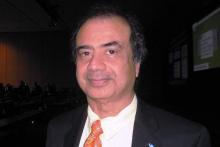“Patients responses have been rapid. The time to response has been 4 weeks in those patients experiencing tumor shrinkage and symptomatic improvement quickly,” Dr. Kwak noted. “Patients have been on treatment sometimes for extended periods of time. … In particular, there are several patients who have been on study for approximately 2 years or more. Of note, of the nine patients who did not have MET amplification in the esophagogastric cancers, none achieved a partial response.”
On the basis of these positive findings, the investigators plan a follow-on single-arm phase II trial among patients with MET-amplified esophagogastric and other cancers, according to Dr. Kwak.
Contrasting with this trial, another presented in the same session by Dr. Manish A. Shah, an associate professor at the Cornell University in New York, had negative findings with onartuzumab, an investigational anti-MET antibody.
A total of 123 patients with HER2-negative metastatic gastroesophageal adenocarcinoma were enrolled in the randomized phase II trial, which was sponsored by Hoffmann-La Roche with collaboration of Genentech, manufacturer of the antibody. The patients were treated with the modified FOLFOX6 chemotherapy regimen plus either placebo or onartuzumab.
Results showed no significant progression-free survival benefit of onartuzumab in the trial population overall or in the patients whose tumors overexpressed MET as determined by immunohistochemistry (IHC), Dr. Shah reported. There was also no signal of benefit in any of a variety patient subgroups.
“One of the main questions of this study is how do we identify tumors that are truly MET driven. Is it IHC? Perhaps it’s amplification, or perhaps it’s something else. I think that’s the main question for MET inhibition moving forward,” commented Dr. Shah.
Dr. Enzinger, the session chair, commented, “This study I think just shows that using immunohistochemistry as a selector probably is not the ideal way of moving forward with this particular pathway, and that this drug, onartuzumab, probably shouldn’t be pursued further in this particular arena.”
Invited discussant Dr. Jaffer A. Ajani, a professor at the University of Texas MD Anderson Cancer Center, Houston, commented, “AMG 337 showed impressive cytotoxic or cytoreductive activity. Granted, it’s only 13 patients, but in 13 patients, 8 is a big number. So here we can say that the biomarker is good and the drug is good, and this should really be pursued further.”
The literature and clinical experience suggest that resistance to this agent will emerge, he added; therefore, combinations of inhibitors of MET and other pathways should be explored.
On the other hand, “antibodies that inhibit the MET receptor have not produced reliable results,” Dr. Ajani maintained, although it is unclear whether the biomarker, the antibody, or both are problematic in this case.
“The solution to the problem is to develop a conjugate—I just call it MET-BOMB – where you can take the antibody and hook it up to a [toxin-]conjugate. In this way, you can make the drug better and you can make the biomarker more relevant,” he concluded.



